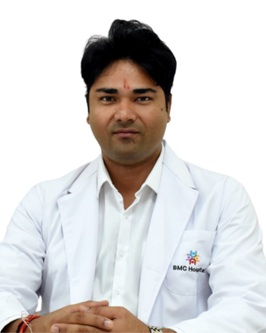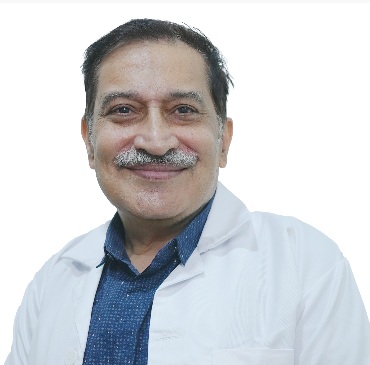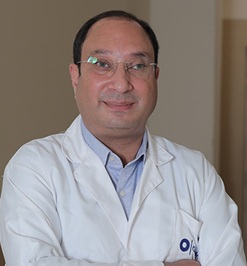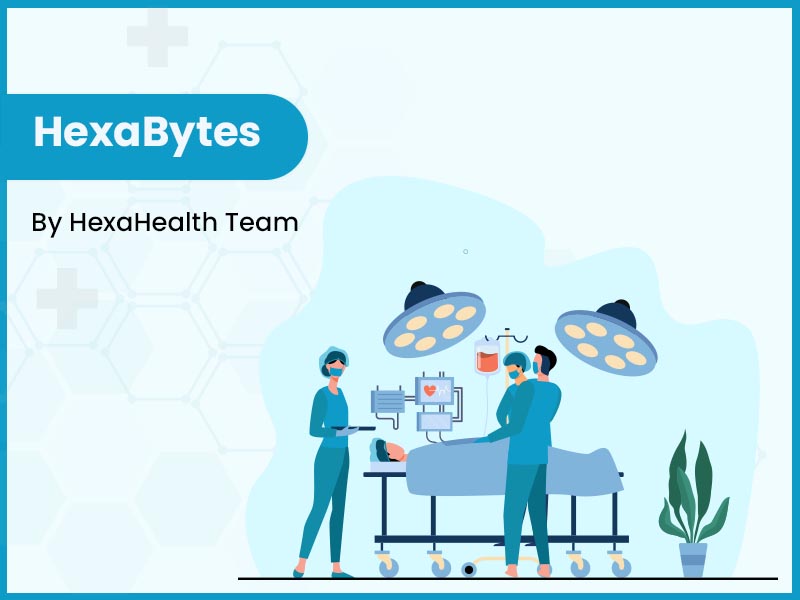Hip Arthroscopy - Procedure, Success Rate, Recovery Time
Dr. Aman Priya Khanna

Treatment Duration
60 Minutes
------ To ------90 Minutes
Treatment Cost
₹ 45,000
------ To ------₹ 2,00,000

According to a study by Arriaza et al., 2024, the prevalence of femoroacetabular impingement (FAI) ranges from 10% to 15% in the general adult population. The incidence is even higher among professional or top-level football players. Hip arthroscopy is a keyhole surgery for addressing this condition and treating various other hip problems.
In cases of persistent hip pain and limited mobility, hip arthroscopy treatment offers a promising solution. This procedure is renowned for its precision and minimal recovery downtime. Continue reading to know more about the benefits, risks, and recovery process of this surgery.
Procedure Name | Hip Arthroscopy |
Alternative Name | Hip scope |
Conditions Treated | Femoroacetabular impingement, labral or tendon tears, dysplasia |
Benefits of the Procedure | Less trauma, faster recovery, outpatient procedure |
Treated By | Orthopaedic surgeon |
You can check Hip Arthroscopy Cost here.
What is hip arthroscopy?
Hip arthroscopy is a minimally invasive method for diagnosing and treating various hip problems. It is particularly beneficial for treating joint issues such as femoroacetabular impingement, labral tears, and loose cartilage. The procedure provides relief from pain and improves joint function.
Anatomy and Physiology of the Hip
The hip is a vital joint in the human body. It functions as a ball-and-socket joint where the thigh bone (femur) meets the hip bone (pelvis).
The joint is responsible for a range of functions, which include:
Balance and support to the upper body
Movement of the upper leg
Weight-bearing
The anatomy of the hip is as follows:
Head and Socket: The head of the femur (ball) fits into the acetabulum (socket) of the pelvis.
Articular Cartilage: Slippery tissue covering the femoral head and acetabulum, facilitating smooth, frictionless movement.
Labrum: A ring of fibrocartilage that fills the space around the socket and enhances the stability of the joint.
Ligaments: Bands of tissue forming a capsule around the joint, holding it together securely.
Synovium: Thin membrane lining the inside of the capsule, producing lubricating synovial fluid.
Hip Arthroscopy Videos by HexaHealth
Expert Doctors (10)
NABH Accredited Hospitals (10)


Need for Hip Arthroscopy
Hip arthroscopy is a suitable procedure for individuals experiencing hip pain. It is particularly beneficial for those not responding well to non-surgical treatment methods like physical therapy and medications. Doctors generally recommend the procedure for younger patients who do not require a hip replacement.
Hip joint surgery is used for several conditions. Some common diseases that can be treated with this procedure include:
Femoroacetabular Impingement (FAI): It is also known as hip impingement. In this condition, the ball and socket joint do not fit together properly due to their irregular shape. The thigh and hip bones rub against each other, causing pain and limiting movement.
Labrum Tears: These are injuries to the labrum that can be caused by trauma or degenerative issues.
Loose Bodies: Small, broken fragments of bone or cartilage in the joint can cause pain.
Tendon Tears: Tendons are fibrous connective tissue that attaches muscle to bone. These can tear away from the bones in the hip during an injury.
Hip Dysplasia: The hip socket is too shallow to cover the femoral head completely.
Synovitis: It is the inflammation of the synovium (a thin membrane that lines the inside of the joint).
Osteophytes: These are bone spurs that develop on the ends of bones. They affect the ability of the joint to move smoothly.
The procedure is not recommended for those with osteoarthritis.
Hip Arthroscopy Procedure
Hip arthroscopy is performed under general or regional (spinal or epidural) anaesthesia to ensure a pain-free procedure. It takes about 90 minutes to complete and involves the following steps:
The surgeon makes two or three small incisions (the size of a buttonhole) around the hip.
Through one of these cuts, they insert the arthroscope, which has a small camera attached to it. This camera sends images to a monitor, allowing the surgeon to see inside the hip joint.
Specialised instruments are inserted through other portals to repair the joint. Common procedures include repairing a torn labrum, removing loose bodies, fixing damaged cartilage, etc.
After the joint is repaired, the arthroscope and instruments are removed. The incisions are closed with sutures.
Before and on the Day of Hip Arthroscopy
Patients are given detailed instructions by their orthopaedic surgeon on how to prepare for hip arthroscopy. Adhering to these guidelines both before and on the day of the procedure is essential for ensuring a smooth surgical experience.
Before Hip Arthroscopy
Preparation for hip surgery begins two weeks before the operation. If the patient smokes, their provider will ask them to quit, as smoking can delay healing. Some other guidelines before the procedure are as follows:
Parameters | Pre-requisites |
Pre-op Assessments |
|
Risk Evaluation |
|
Restrictions | Blood-thinning medications two weeks before surgery |
Anaesthesia Selection | General or regional |
Fasting | 6 to 12 hours before the procedure |
On the Day of Hip Arthroscopy
On the day of the procedure, patients arrive at the hospital early to complete last-minute health assessments. Once admitted, they undergo preparations for surgery, which include the following steps:
Parameters | Pre-requisites |
Consent | Mandatory |
Physical Evaluation | Vitals check-up (temperature, blood pressure, breathing, etc.) |
Surgical Preparation | Marking the skin where incisions will be made |
IV Line | Yes |
Patient Positioning | Supine or lateral with the leg attached to a special positioning device |
After Hip Arthroscopy and Recovery
Hip scope recovery is generally quick, with most patients experiencing healing within six weeks. However, the exact duration can vary between individuals depending on their health and need for surgery.
In Hospital Recovery
Hip arthroscopy is generally performed as an outpatient procedure. This means that patients can return home on the same day of the surgery. They may need to stay in the hospital for 1-2 hours before discharge. During this time, one can expect the following:
The patient is transferred to the recovery room, where the anaesthesiologist monitors the effect of anaesthesia.
The nursing staff checks the individual’s vital signs, including blood pressure, heart rate, and oxygen.
Pain medications are given to manage post-operative discomfort.
At-home Recovery
Patients can expect to resume work within one to two weeks after surgery. It is essential to follow certain guidelines to ensure a smooth recovery after the procedure. These include:
Keep the incision site clean and dry to prevent infection.
Take prescribed medications to manage pain.
Ice and elevate the hip to reduce swelling.
Wear a brace on the hip for three weeks.
Use crutches for two to six weeks.
Do not put any weight on the affected hip for a week.
Refrain from heavy exercise or sports for 12 weeks.
Perform physical therapy exercises to regain mobility and strength.
First Follow-up Appointment
The first follow-up appointment is scheduled seven to ten days after the procedure. During this visit, the doctor removes sutures. They also perform X-ray or other imaging studies to assess recovery of the hip joint.
Benefits of Hip Arthroscopy
It is a minimally invasive technique that offers various benefits for people with hip joint problems. The hip arthroscopy success rate is generally high, reflecting the effectiveness of the operation. Some other advantages over the traditional approach include:
Less tissue damage, scarring, and hip pain.
Shorter recovery time.
Performed as an outpatient procedure (individuals return home on the same day of the surgery).
Lower risk of complications than invasive methods.
Postpones or eliminates the need for hip replacement surgery by treating conditions that cause osteoarthritis.
Risks and Complications of Hip Arthroscopy
Hip arthroscopy is generally a safe procedure with fewer complications than more invasive procedures. However, like any surgical intervention, it has some risks, which include the following:
Infection
Blood clots in the legs (deep vein thrombosis) or lungs (pulmonary embolism)
Bleeding in the joint
Temporary nerve damage (causing numbness, tingling, or pain)
Damage to the cartilage, bone, labrum, or other tissues
Instability of the hip
When to consult a doctor?
After undergoing hip arthroscopy, it is important to know when to consult a doctor to address potential complications or monitor recovery. The following are specific situations that warrant a need for medical attention post-procedure:
Increased pain
Bleeding at the incision site
Nausea and vomiting
Infection signs like discolouration at the surgical site of fever exceeding 101℉
Risks of Delaying Hip Arthroscopy
Delaying hip arthroscopy can lead to several potential complications, especially if underlying conditions are left untreated. Below are some risks associated with postponing the procedure:
Progression of Damage: Conditions such as labral tears or femoroacetabular impingement (FAI) can worsen over time. Delaying surgery can lead to more extensive damage that may become harder to repair and might require more invasive surgery later.
Degenerative Changes: As the condition progresses, it can escalate to osteoarthritis. This can cause increased pain and affect long-term mobility.
Cost of Hip Arthroscopy
The hip surgery cost in India can vary from one person to another based on various factors. The price ranges between ₹ 45,000 and ₹ 2,00,000. The average expense of the procedure is ₹ 1,30,000.
Procedure Name | Estimated Cost Range |
Hip Arthroscopy | ₹ 45,000 to ₹ 2,00,000 |
Note: The figures mentioned above are approximate. For accurate pricing details, patients are advised to consult HexaHealth experts.
Factors that affect the expenses of surgery include:
Hospital: The type of healthcare facility where the procedure is performed can impact costs. Private hospitals tend to have higher costs than government centres.
Surgeon’s Expertise: Medical experts with specialised training and extensive experience may charge more for their services.
Location: The geographical region of the hospital where the procedure is performed can affect prices due to variations in the cost of living.
Diagnostic Imaging: Pre-operative testing, such as MRI or CT scans, assesses the condition of the hip joint. The cost of these assessments can contribute to the overall expense.
Post-operative Care: Expenditures related to medications, physical therapy, and follow-up appointments can increase the final bill for hip arthroscopy.
Takeaway
Hip arthroscopy is a minimally invasive procedure with the potential to diagnose and treat various hip joint conditions effectively. It offers patients relief from pain, improved mobility, and the possibility of avoiding more invasive surgeries like hip replacements.
If you or your loved ones are considering hip arthroscopy treatment, choosing HexaHealth can be the right choice. We connect you with top orthopaedic surgeons for the procedure. Our team helps you achieve the best results with minimal discomfort and downtime. Contact us today!
Suggested Reads
| Hip Fracture |
Osteoarthritis Hip |
| Hip Pain Exercises |
Total Hip Replacement |
Frequently Asked Questions (FAQ)
What is hip arthroscopy?
Hip arthroscopy is a surgical procedure that utilises a small camera called an arthroscope to view and repair the inside of the hip joint. This technique allows surgeons to diagnose and treat various hip problems without making large incisions.
What are the benefits of hip arthroscopy compared to other hip surgeries?
Being a keyhole surgery, hip arthroscopy treatment offers several benefits compared to other hip procedures. These include the following:
Less post-operative pain
Quicker recovery time
Smaller scars
Lower risk of complications
Outpatient procedure
How is hip arthroscopy performed?
Hip arthroscopy is performed under general or regional anaesthesia by an orthopaedic surgeon. It involves the following steps:
Making small incisions around the hip
Inserting a camera called an arthroscope to visualise the joint
Using specialised instruments to repair or remove damaged tissue
Is hip arthroscopy surgery covered under insurance?
Yes, hip joint surgery is covered under insurance. However, coverage can differ depending on the specific policy. Patients should consult HexaHealth experts to understand the details of their plan.
How much does hip surgery cost?
The hip surgery cost can vary widely, generally ranging from ₹ 45,000 to ₹ 2,00,000. It depends on the complexity of the procedure, the surgeon’s experience, and the facility. HexaHealth consultants can provide up-to-date pricing information based on an individual’s situation.
Are there any risks of hip arthroscopy surgery?
Hip arthroscopy is generally considered a safe procedure due to its minimally invasive nature. However, like any other surgery, it carries certain risks, including:
Infection
Nerve damage
Blood clots
Bone, cartilage, or labrum damage
Complications from anaesthesia
What is the expected recovery time after hip arthroscopy?
The expected recovery time after hip arthroscopy is six weeks. Patients can resume work within 1-2 weeks after the procedure. However, the exact duration depends on the patient’s health and the need for the surgery.
What to expect in hip scope recovery?
Hip scope recovery involves rest, followed by physical therapy. Patients can expect the following during recovery:
Take pain medications prescribed by the doctor
Avoid placing any weight on the affected hip for the first week
Wear a hip brace for three weeks
Use crutches for two to six weeks
How soon can I return to normal activities after hip arthroscopy?
Most individuals can resume normal activities within one to two weeks after hip arthroscopy, depending on their rate of recovery. Return to sports or strenuous activities may take up to 12 weeks.
Is hip arthroscopy treatment successful?
Hip arthroscopy success rate can differ based on the patient’s health and the condition being treated. According to a study by Youm et al., 2016, the overall success rate of the procedure in treating femoroacetabular impingement is 81.1%.
Are there any specific exercises recommended after hip arthroscopy?
After hip arthroscopy, a physical therapist will recommend specific exercises to ensure safe and effective rehabilitation. Some of these exercises may include:
Ankle pumps
Quad sets
Glute sets
Heel digs
Is hip arthroscopy risky?
Hip arthroscopy is generally considered safe but carries risks like any surgery. These include infection, nerve damage, blood clots, and potential complications related to the anaesthesia.
What should I avoid after hip arthroscopy?
Post-operative care after hip arthroscopy is important to ensure a successful recovery. Patients should avoid the following after the procedure:
High-impact activities
Placing too much weight on the hip
Bathing until the doctor approves (sponge bath)
How do you sleep after hip arthroscopy?
After hip surgery, patients should sleep on their back for 1-2 weeks. Their heels should be raised in an inclined position on a pile of pillows. Avoid sleeping on the operated side to prevent pressure on the hip.
Hip Arthroscopy Cost Videos
References
All the articles on HexaHealth are supported by verified medically-recognized sources such as; peer-reviewed academic research papers, research institutions, and medical journals. Our medical reviewers also check references of the articles to prioritize accuracy and relevance. Refer to our detailed editorial policy for more information.
- Arriaza R, Saavedra-García M, Arriaza A, Cruz-Cámara A, Leyes M, Cerezal L, et al. Prevalence of hip femoroacetabular impingement deformities in high-level (La Liga) male professional football players. BMC Musculoskeletal Disorders. 2024 Feb 21;25(1).

- Cleveland Clinic. Hip Joint: Anatomy & How It Works [Internet]. Cleveland Clinic. 2023.

- Hip Arthroscopy - OrthoInfo - AAOS [Internet]. Aaos.org. 2016.

- Hip Arthroscopy [Internet]. www.hopkinsmedicine.org. 2022.

- Hip arthroscopy: MedlinePlus Medical Encyclopedia [Internet]. medlineplus.gov. [cited 2024 May 4].

- Hip Arthroscopy: What It Is, Procedure, and Recovery [Internet]. Cleveland Clinic.

- Hip Arthroscopy: A Minimally Invasive Hip Scope Procedure [Internet]. Hospital for Special Surgery.

- Stubbs AJ, Beck EC, Howse EA, Koulopoulos M. Hip Arthroscopy: Supine Approach to Patient Positioning, Setup, and Traction. Springer eBooks. 2022 Jan 1;247–55.

- Mehta MP, Hoffer-Hawlik MA, O’Connor M, Lynch TS. Immediate Versus Delayed Hip Arthroscopy for Femoroacetabular Impingement: An Expected Value Decision Analysis. JAAOS Global Research & Reviews [Internet]. 2020 Dec 1 [cited 2023 Mar 23];4(12):e20.00206.

- Femoroacetabular Impingement (FAI) | Cleveland Clinic [Internet]. Cleveland Clinic. 2019.

- Hip Arthroscopy Recovery | University of Utah Health [Internet]. healthcare.utah.edu. 2021 [cited 2024 May 4].

Last Updated on: 6 May 2024
Reviewer

Dr. Aman Priya Khanna
MBBS, DNB General Surgery, Fellowship in Minimal Access Surgery, FIAGES
14 Years Experience
Dr Aman Priya Khanna is a well-known General Surgeon, Proctologist and Bariatric Surgeon currently associated with HealthFort Clinic, Health First Multispecialty Clinic in Delhi. He has 14 years of experience in General Surgery, Proctolo...View More
Author

She has extensive experience in content and regulatory writing with reputed organisations like Sun Pharmaceuticals and Innodata. Skilled in SEO and passionate about creating informative and engaging medical conten...View More
Latest Health Articles





























